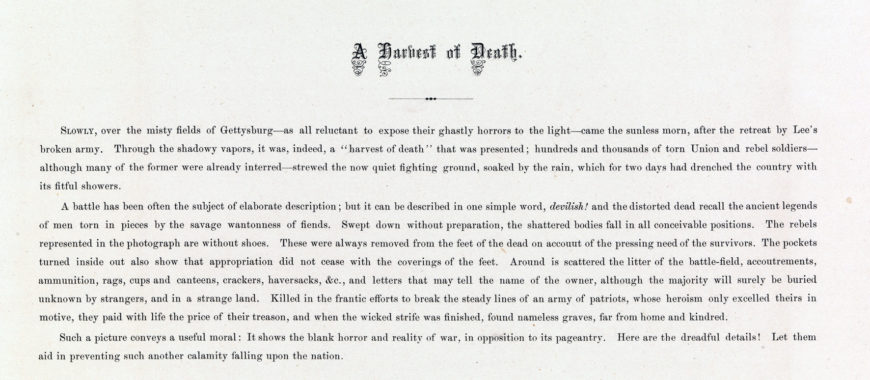One of the most famous landscape photographs showing the horrible aftermath of the Battle of Gettysburg.
Timothy O’Sullivan, A Harvest of Death, 1863, albumen print, 17.2 × 22.5 cm, illustration in Alexander Gardner’s Photographic Sketchbook of the War, 1866 (Library of Congress); a conversation between Dr. Kimberly Kutz Elliott and Dr. Steven Zucker
Important concepts
- war photography
- collodion process
- The Civil War and the Battle of Gettysburg
This photograph was included in Gardner’s Photographic Sketch Book of the War (1866). Each photograph had a lengthy caption that explained what was captured in each scene.

Gardner’s Photographic Sketch Book of the War, 1866 (The Metropolitan Museum of Art)
For the “Harvest of Death” photo the caption read: “It was, indeed, a ‘harvest of death.’ . . . Such a picture conveys a useful moral: It shows the blank horror and reality of war, in opposition to its pageantry. Here are the dreadful details! Let them aid in preventing such another calamity falling upon the nation.”
Additional resources
The Gettysburg Address—setting and context, with Dr. Kimberly Kutz Elliott
The Gettysburg Address—full text and analysis, with Dr. Kimberly Kutz Elliott
See more photos from Alexander Gardner’s Photographic Sketch Book of the War at the Met
Learn more about the wet plate photography process from PBS
William A. Frassanito, Gettysburg: A Journey in Time (Scribner, 1975), and Early Photography at Gettysburg (Thomas, 1996).
D. Mark Katz, Witness to an Era: The Life and Photographs of Alexander Gardner (Rutledge Hill Press, 1999).
Richard S. Lowry, The Photographer and the President: Abraham Lincoln, Alexander Gardner, and the Images that Made a Presidency (Rizzoli, 2015).
[0:00] [music]
Dr. Steven Zucker: [0:04] We’re looking at one of the most famous photographs in the history of the United States. This is Timothy O’Sullivan’s “A Harvest of Death” at the battle of Gettysburg. It’s an image that has been used to illustrate countless lessons on the American Civil War.
Dr. Kimberly Kutz Elliott: [0:20] Gettysburg is in the third year of the US Civil War, which started in 1861 when southern states seceded to protect slavery.
Dr. Zucker: [0:32] And Gettysburg is a little town that happened to be the place where the US Army confronted the Confederate general Lee’s second attempt to invade the North.
Dr. Kutz Elliott: [0:42] And this battle is a turning point. Things had not been going well for the US Army. There’s some talk about maybe making peace and allowing the southern states to go their own way.
[0:53] The southerners are hoping that they’ll get international recognition from England and France, that they can continue as a separate country. They make this invasion of the North to try to end the war. This battle takes place over three days, from July 1st through 3rd, 1863. It is the battle with the single highest number of casualties in the entire Civil War.
[1:20] News of the victory of US troops gets to Washington D.C., the capital, on the afternoon of July 4th, 1863. Independence Day turns into this enormous celebration of an important victory.
Dr. Zucker: [1:37] When we think about victory in the history of art, what comes to mind are triumphant images, with flags waving. What we’re seeing here, is something very different.
Dr. Kutz Elliott: [1:46] It really turns the whole notion of a history painting of a great battle on its head.
[1:53] We don’t have Liberty leading the people here, we don’t have Napoleon on horseback, what we have are some dead bodies that have been out in the heat and rain for a number of days.
[2:05] We see that the men laying here have lost their shoes, pockets are turned inside-out, belongings scattered around them. There have been battlefield scavengers who have come and taken their shoes, taken perhaps money in their pockets.
Dr. Zucker: [2:22] This is not a random image. The photographer found a perspective that met his criteria.
Dr. Kutz Elliott: [2:27] O’Sullivan and Gardner thought of themselves as artists and did not hesitate to set the scene, or even add props, to make the narrative of the photographs more interesting.
Dr. Zucker: [2:41] We know that in certain cases, the photographer and his assistants would actually move bodies and some of the debris of the battlefield in order to create a more perfect image. We don’t know if that’s the case here.
[2:53] In 1863, photography was an extremely deliberate process. This is a wet collodion print. The process was a difficult one, and required very heavy equipment that had to be brought onto the battlefield, in this case in a wagon with multiple people working together. This was a very time-sensitive, very labor-intensive process.
Dr. Kutz Elliott: [3:14] When news of the battle came to Washington, D.C., you would have had Alexander Gardner, who was one of the foremost photographers of his era, gather his operators, among them Timothy O’Sullivan, [and] get into a wagon. They’re delayed by rain. It takes them a couple days to get to Gettysburg, and then it’s a three-man process.
[3:36] Remember that not only has it been raining and it’s muddy, but thousands of bodies are decomposing. The battle also led to the death of thousands of horses, whose carcasses were put in piles and burned. Gardner and his operators would have smeared peppermint oil underneath their noses so that they could bear just how it smelled to stand there. This would have been very unpleasant work.
Dr. Zucker: [4:02] Battlefield photography was new. There had been photographs taken during the Mexican-American War, and the very first battlefield photographs were taken during the Crimean War, so it was extremely novel to see images like this.
[4:15] We have empty grass in the immediate foreground that allows our eye to enter into the scene. We’re stopped, though, almost immediately, by this horizontal line of bodies, most forcefully by a man whose mouth is open, whose body is bloated.
[4:31] Our eye then moves across, and we see bodies set up in a line moving away from our eye, setting up a kind of measured recession. Once we’ve reached that further point, we see another line of bodies and debris, a man on horseback, a man standing beside what might be a wagon, beyond that, a distant hill, and lost in mist or perhaps smoke, trees and hills.
[4:55] The hills dip and create almost a vanishing point, and so whether or not by chance or by design, this is a photograph, for all of its horror, that is still following the formulas of landscape painting that have come down to us from the Renaissance.
Dr. Kutz Elliott: [5:10] These bodies of US soldiers would shortly be interred, and after that, moved into a cemetery for those who fell. It’s at the dedication for that cemetery that Abraham Lincoln, the President of the United States, delivered his Gettysburg Address.
[5:30] That address tried to draw a relationship between the people who died at Gettysburg and the greater cause for which the United States was fighting.
[5:41] He said, “…from these honored dead we take increased devotion to that cause for which they gave the last full measure of devotion, that we here highly resolve that these dead shall not have died in vain, that this nation, under God, shall have a new birth of freedom, and that government of the people, by the people, for the people, shall not perish from the earth.”
[6:05] This famous photograph tells us so much about death and sacrifice during the Civil War.
[6:11] [music]

